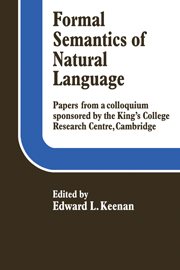Book contents
- Frontmatter
- Contents
- Notes on the contributors
- Acknowledgements
- Introduction
- I QUANTIFICATION IN NATURAL LANGUAGE
- II REFERENCE AND CROSS REFERENCE
- III INTENSIONAL LOGIC AND SYNTACTIC THEORY
- Two theories about adjectives
- Partial interpretations
- Subcategorization of adnominal and adverbial modifiers
- Should generative semantics be related to intensional logic?
- Transformational semantics
- IV QUESTIONING MODEL THEORETIC SEMANTICS
- V PRAGMATICS AND SENTENCES IN CONTEXT
- VI SEMANTICS AND SURFACE SYNTAX
Partial interpretations
Published online by Cambridge University Press: 05 November 2011
- Frontmatter
- Contents
- Notes on the contributors
- Acknowledgements
- Introduction
- I QUANTIFICATION IN NATURAL LANGUAGE
- II REFERENCE AND CROSS REFERENCE
- III INTENSIONAL LOGIC AND SYNTACTIC THEORY
- Two theories about adjectives
- Partial interpretations
- Subcategorization of adnominal and adverbial modifiers
- Should generative semantics be related to intensional logic?
- Transformational semantics
- IV QUESTIONING MODEL THEORETIC SEMANTICS
- V PRAGMATICS AND SENTENCES IN CONTEXT
- VI SEMANTICS AND SURFACE SYNTAX
Summary
Statement of the problem
Natural languages contain many expressions which are grammatically well-formed but meaningless; they are assembled from meaningful words or morphemes in accordance with the syntactic rules of the language but no meaning is conferred upon them by the semantic rules of the language. When we call expressions or utterances ‘meaningless’ here without further qualification, that will just be for the sake of brevity. We want to indicate by that term that the expressions or utterances are semantically anomalous in such a way that they will generally evoke responses like ‘What do you mean?’ or ‘What are you talking about?’ There is no implication that they are on a par with totally meaningless expressions as Krz is thwing.
Let us take six typical examples of such well-formed but meaningless expressions:
(1) Incompletely defined functors: Many predicates are not defined for all syntactically permissible arguments. Thus the verb to run is defined for animals with locomotive appendages, for humans, machines, fluids and for noses, not however for plants, minerals or numbers. And the German verb lachen is defined only for humans and the sun. The sentence Der Mond lacht, though constructed grammatically just as Die Sonne lacht, has, in distinction to the latter, no meaning.
(2) Non-existing objects: Sentences about objects which do not exist or no longer exist form a significant sub-category of example (1). The sentences Odysseus is (now) shaving himself and Eisenhower is (now) sick are meaningless but not the sentences Professor Snell is dreaming of Odysseus or Nixon remembers Eisenhower.
- Type
- Chapter
- Information
- Formal Semantics of Natural Language , pp. 156 - 174Publisher: Cambridge University PressPrint publication year: 1975
- 2
- Cited by



